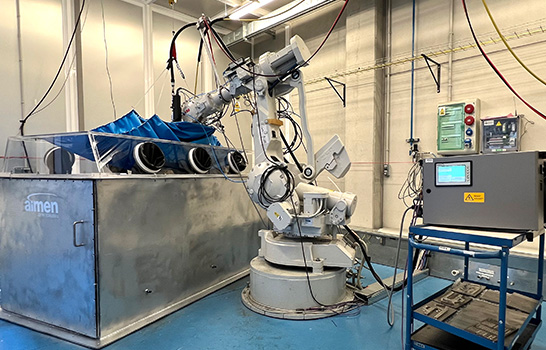
The Pilot Test Bed Facility for wire AM at AIMEN uses the Laser Metal Deposition (LMD) concept to process various metallic alloys including Aluminum and Al composites The metallic wire is supplied in the laser focal point, molten and deposited in weldseams. The final set of weldseams composes the three-dimensional component. The system consists of a robotic arm (e.g. ABB IRB 4400),a TruDisk 16002 16kW laser source coupled to a 200mμ fiber and laser beam quality of 8mm mrad. The laser head is a Trumph BEO D70, but a specific one will be incorporated in the project (e.g. Precitec CoaxPrinter). The wire supply is based on Fronius TPS 5000 with Robacta drive wire feeder (Ø0.8-2.4mm wires) that allows the adjustment of laser beamwire position with a 3 degrees of freedom mechanical positioning system. The unit is accompanied by a laser radiation protective enclosure which will be sealed in the project and equipped with continuous gas supply.

Installation of a real time monitoring system for Al and Mg wire processing. New
protocols for processing wires containing NPs. Application of inert atmosphere
to avoid oxidation and reaction when operating Ti and Mg alloys.
The target materials of WLAM pilot line are:
Al MMnC: excellent grain shaping improvement leading to higher fatigue properties - large size aircraft components, lightweight naval structures;
Ti MMnC: highly superior tensile and fatigue properties: structural components in aircraft industry,
Mg MMnC: high strength – weight ratio - ultralight automotive components,
Steel MMnC significant improvement of hardness and wear resistance – moulds and dies for stamping and deep drawing
The standardized procedure for process parameters optimization (AM setup, process window setup and validation by test artefacts manufacturing), on one hand side, and a fully controlled pilot line (atmosphere with below 50ppm in Oxigen and IR imaging for process monitoring) will lead to significant stability in the process. Together with incremental approach to build the incoming process development on the basis of previous developments, it will enable faster setup of a process for an MMnC (target: 2 weeks for process optimization of a material in comparison to today’s more than a 10 weeks of process development for common materials).